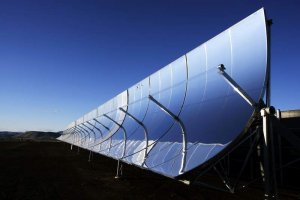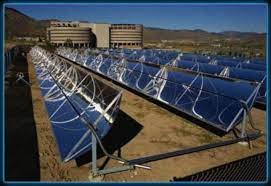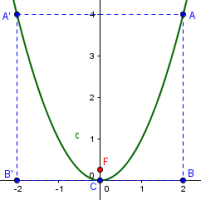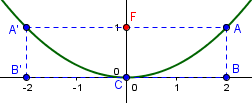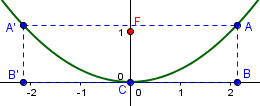Bad at Math Mike
New member
- Joined
- Jul 4, 2022
- Messages
- 4
Hello!
I am designing a linear solar concentrator for my (future) greenhouse. These devices use parabolic mirrors to reflect sunlight on to a heat absorption tube mounted longitudinally at the focal point. The tube is filled with a fluid that absorbs heat; the heated fluid is then pumped to thermal storage tanks for future use (steam turbines, or in my case, radiators). See pics if you are not familiar with these.
My reflector will be made of a flexible rectangular mirror (acrylic mirror sheet or tiles) with a dimension of either 24", 30" or 36" height (width TBD, not important right now, probably 48"), depending on my limited budget. Unlike the commercial versions as seen in the pics, for protection against the elements, my concentrator will be housed in a glazed (side facing the sun will be glass) box of a size and weight that can be easily handled, mounted, and adjusted to match the sun's angle over the year. This also means, if possible, a minimum distance to the focal point to minimize the box size.
(I realize the glazing will reduce the sunlight available, up to 10%, but I think mounting the reflector and absorption tube in an insulated glazed box will reduce heat loss and somewhat offset the loss of light)
The math help I need: I need parabola profiles given the mirror dimension of 24", 30" or 36" height and if possible, that minimize the distance to the focal point. There are limits to the flexibility of the mirror material, but I think based on the images I've seen of these collectors, any working parabola will not be severely curved enough to present a problem for the mirrors.
Is there a graphing program for math dummies like me so I can create different parabolas? Ultimately, I need a scalable image of a suitable parabola and focal point that I can print actual size for a template when building the mirror support and placing the heat absorption tube.
Thanks in advance for any assistance!
Mike
I am designing a linear solar concentrator for my (future) greenhouse. These devices use parabolic mirrors to reflect sunlight on to a heat absorption tube mounted longitudinally at the focal point. The tube is filled with a fluid that absorbs heat; the heated fluid is then pumped to thermal storage tanks for future use (steam turbines, or in my case, radiators). See pics if you are not familiar with these.
My reflector will be made of a flexible rectangular mirror (acrylic mirror sheet or tiles) with a dimension of either 24", 30" or 36" height (width TBD, not important right now, probably 48"), depending on my limited budget. Unlike the commercial versions as seen in the pics, for protection against the elements, my concentrator will be housed in a glazed (side facing the sun will be glass) box of a size and weight that can be easily handled, mounted, and adjusted to match the sun's angle over the year. This also means, if possible, a minimum distance to the focal point to minimize the box size.
(I realize the glazing will reduce the sunlight available, up to 10%, but I think mounting the reflector and absorption tube in an insulated glazed box will reduce heat loss and somewhat offset the loss of light)
The math help I need: I need parabola profiles given the mirror dimension of 24", 30" or 36" height and if possible, that minimize the distance to the focal point. There are limits to the flexibility of the mirror material, but I think based on the images I've seen of these collectors, any working parabola will not be severely curved enough to present a problem for the mirrors.
Is there a graphing program for math dummies like me so I can create different parabolas? Ultimately, I need a scalable image of a suitable parabola and focal point that I can print actual size for a template when building the mirror support and placing the heat absorption tube.
Thanks in advance for any assistance!
Mike

